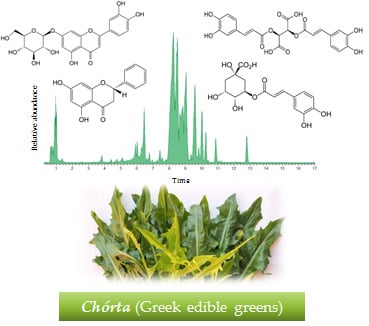Phytochemical Composition of the Decoctions of Greek Edible Greens (Chórta) and Evaluation of Antioxidant and Cytotoxic Properties
Abstract
1. Introduction
2. Results
2.1. Preparation of Decoctions, Enrichement and Isolation
2.2. UPLC-HRMS-ESI(−) and HRMS/MS Profiling of the Enriched Chórta Decoctions
2.3. Evaluation of Cytotoxicity and Antioxidant Activity
3. Discussion
4. Materials and Methods
4.1. Materials and Chemicals
4.2. Plant Material Extraction, Enrichment of Extracts and Isolation of Principal Components
4.3. Qualitative Composition Analysis of chórta Extracts: UPLC-ESI(−)-HRMS and HRMS/MS Conditions
4.4. DPPH (2,2-diphenyl-1-picrylhydrazyl) Radical Scavenging Assay
4.5. Cell Lines and Cell Culture Conditions
4.6. Cell Survival Assay
5. Conclusions
Supplementary Materials
Author Contributions
Funding
Acknowledgments
Conflicts of Interest
References
- Panza, F.; Solfrizzi, V.; Colacicco, A.; D’Introno, A.; Capurso, C.; Torres, F.; Del Parigi, A.; Capurso, S.; Capurso, A. Mediterranean diet and cognitive decline. Public Health Nutr. 2004, 7, 959–963. [Google Scholar] [CrossRef] [PubMed]
- Trichopoulou, A.; Costacou, T.; Bamia, C.; Trichopoulos, D. Adherence to a Mediterranean Diet and Survival in a Greek Population. N. Engl. J. Med. 2003, 348, 2599–2608. [Google Scholar] [CrossRef] [PubMed]
- Trichopoulou, A.; Vasilopoulou, E. Mediterranean diet and longevity. Br. J. Nutr. 2000, 84, S205–S209. [Google Scholar] [CrossRef] [PubMed]
- Dai, J.; Jones, D.P.; Goldberg, J.; Ziegler, T.R.; Bostick, R.M.; Wilson, P.W.; Manatunga, A.K.; Shallenberger, L.; Jones, L.; Vaccarino, V. Association between adherence to the Mediterranean diet and oxidative stress. Am. J. Clin. Nutr. 2008, 88, 1364–1370. [Google Scholar] [CrossRef] [PubMed]
- Hadjichambis, A.C.H.; Paraskeva-hadjichambi, D.; Giusti, M.E.; De Pasquale, C.; Lenzarini, C.; Gonzales-tejero, M.R.; Sanchez-Rojas, C.P.; Skoula, M.; Johnson, C.; Sarpaki, A.; et al. Wild and semi-domesticated food plant consumption in seven circum-Mediterranean areas. Int. J. Food Sci. Nutr. 2009, 59, 383–414. [Google Scholar] [CrossRef]
- Leonti, M.; Nebel, S.; Rivera, D.; Heinrich, M.; Leonti, M. Wild gathered food plants in the European Mediterranean: A comparative analysis. Econ. Bot. 2006, 60, 130–142. [Google Scholar] [CrossRef]
- Vasilopoulou, E.; Trichopoulou, A. Green pies: The flavonoid rich Greek snack. Food Chem. 2011, 126, 855–858. [Google Scholar] [CrossRef]
- Megaloudi, F. Wild and Cultivated Vegetables, Herbs and Spices in Greek Antiquity (900 B.C. to 400 B.C.). Environ. Archaeol. 2005, 10, 73–82. [Google Scholar] [CrossRef]
- Conforti, F.; Sosa, S.; Marrelli, M.; Menichini, F.; Statti, G.A.; Uzunov, D.; Tubaro, A.; Menichini, F. The protective ability of Mediterranean dietary plants against the oxidative damage: The role of radical oxygen species in inflammation and the polyphenol, flavonoid and sterol contents. Food Chem. 2009, 112, 587–594. [Google Scholar] [CrossRef]
- Trichopoulou, A.; Vasilopoulou, E.; Hollman, P.; Chamalides, C.; Foufa, E. Nutritional composition and flavonoid content of edible wild greens and green pies: A potential rich source of antioxidant nutrients in the Mediterranean diet. Food Chem. 2000, 70, 319–323. [Google Scholar] [CrossRef]
- Vasilopoulou, E.; Georga, K.; Joergensen, M.B.; Naska, A.; Trichopoulou, A. The Antioxidant Properties of Greek Foods and the Flavonoid Content of the Mediterranean Menu. Curr. Med. Chem. Immunol. Endocr. Metab. Agents 2005, 5, 33–45. [Google Scholar] [CrossRef]
- Vardavas, C.I.; Majchrzak, D.; Wagner, K.H.; Elmadfa, I.; Kafatos, A. The antioxidant and phylloquinone content of wildly grown greens in Crete. Food Chem. 2006, 99, 813–821. [Google Scholar] [CrossRef]
- García-Herrera, P.; Sánchez-Mata, M.C.; Cámara, M.; Fernández-Ruiz, V.; Díez-Marqués, C.; Molina, M.; Tardío, J. Nutrient composition of six wild edible Mediterranean Asteraceae plants of dietary interest. J. Food Compos. Anal. 2014, 34, 163–170. [Google Scholar] [CrossRef]
- Zeghichi, S.; Kallithraka, S.; Simopoulos, A.P.; Kypriotakis, Z. Nutritional Composition of Selected Wild Plants in the Diet of Crete. In Plants in Human Health and Nutrition Policy; Karger: Basel, Switzerland, 2003; Volume 91, pp. 22–40. ISBN 978-3-8055-7554-6. [Google Scholar]
- Savona-Ventura, C. Fenugreek: A natural prototype oral hypoglycaemic agent used in Malta. Malta Med. J. 2009, 21, 41–44. [Google Scholar]
- Street, R.A.; Sidana, J.; Prinsloo, G. Cichorium intybus: Traditional uses, phytochemistry, pharmacology, and toxicology. Evid. Based Complement. Altern. Med. 2013, 2013, 1–13. [Google Scholar] [CrossRef] [PubMed]
- Gogonaki, K. Native Edible Greens Used in the Area of Chania. Bachelor’s Thesis, School of Agriculture, Food and Nutrition, Technological Educational Institute of Crete, Chania, Greece, 2010. [Google Scholar]
- Della, A.; Paraskeva-Hadjichambi, D.; Hadjichambis, A.C. An ethnobotanical survey of wild edible plants of Paphos and Larnaca countryside of Cyprus. J. Ethnobiol. Ethnomed. 2006, 2. [Google Scholar] [CrossRef] [PubMed]
- Nebel, S.; Pieroni, A.; Heinrich, M. Ta chórta: Wild edible greens used in the Graecanic area in Calabria, Southern Italy. Appetite 2006, 47, 333–342. [Google Scholar] [CrossRef] [PubMed]
- Tardio, J.; de Cortes Sanchez-Mata, M.; Morales, R.; Molina, M. Ethnobotanical and Food Composition Monographs of Selected Mediterranean Wild Edible Plants. In Mediterranean Wild Edible Plants: Ethnobotany and Food Composition Tables; Springer: Berlin/Heidelberg, Germany, 2016; pp. 273–470. ISBN 9781493933297. [Google Scholar]
- Tardío, J.; Pardo-de-santayana, M.; Morales, R. Ethnobotanical review of wild edible plants in Spain. Bot. J. Linn. Soc. 2006, 152, 27–71. [Google Scholar] [CrossRef]
- Ghirardini, M.P.; Carli, M.; Vecchio, N.; Rovati, A.; Cova, O.; Valigi, F.; Agnetti, G.; Macconi, M.; Adamo, D.; Traina, M.; et al. The importance of a taste. A comparative study on wild food plant consumption in twenty-one local communities in Italy. J. Ethnobiol. Ethnomed. 2007, 3, 22–36. [Google Scholar] [CrossRef] [PubMed]
- Turner, N.J.; Łuczaj, Ł.J.; Migliorini, P.; Pieroni, A.; Dreon, A.L.; Sacchetti, L.E.; Paoletti, M.G. Edible and Tended Wild Plants, Traditional Ecological Knowledge and Agroecology. CRC Crit. Rev. Plant Sci. 2011, 30, 198–225. [Google Scholar] [CrossRef]
- Brieudes, V.; Angelis, A.; Vougogiannopoulou, K.; Pratsinis, H.; Kletsas, D.; Mitakou, S.; Halabalaki, M.; Skaltsounis, L.A. Phytochemical Analysis and Antioxidant Potential of the Phytonutrient-Rich Decoction of Cichorium spinosum and C. intybus. Planta Med. 2016, 82, 1070–1078. [Google Scholar] [CrossRef] [PubMed]
- Melliou, E.; Magiatis, P.; Skaltsounis, A.-L. Alkylresorcinol Derivatives and Sesquiterpene Lactones from Cichorium spinosum. J. Agric. Food Chem. 2003, 51, 1289–1292. [Google Scholar] [CrossRef] [PubMed]
- Spanou, C.; Bourou, G.; Dervishi, A.; Aligiannis, N.; Angelis, A.; Komiotis, D.; Skaltsounis, A.L.; Kouretas, D. Antioxidant and chemopreventive properties of polyphenols compounds derived from Greek legume plant extracts. J. Agric. Food Chem. 2008, 56, 6967–6976. [Google Scholar] [CrossRef] [PubMed]
- Lazari, D.M.; Skaltsa, H.D.; Constantinidis, T. Volatile constituents of Centaurea raphanina Sm. subsp. mixta (DC.) Runemark and C. spruneri Boiss. & Heldr. (Asteraceae), growing wild in Greece. Flavour Fragr. J. 1999, 14, 415–418. [Google Scholar] [CrossRef]
- Panagouleas, C.; Skaltsa, H.; Lazari, D.; Skaltsounis, L.; Sokovic, M.; Panagouleas, C.; Skaltsa, H.; Lazari, D.; Skaltsounis, A.; Sokovic, M. Antifungal Activity of Secondary Metabolites of Centaurea raphanina ssp. mixta, Growing Wild in Greece. Pharm. Biol. 2008, 41, 266–270. [Google Scholar] [CrossRef]
- Louche, L.; Gaydou, E.; Lesage, J.-C. Determination of Phlorin as Peel Marker in Orange (Citrus sinensis) Fruits and Juices. J. Agric. Food Chem. 1998, 46, 4193–4197. [Google Scholar] [CrossRef]
- Xu, X.; Xie, H.; Hao, J.; Jiang, Y.; Wei, X. Flavonoid glycosides from the seeds of Litchi chinensis. J. Agric. Food Chem. 2011, 59, 1205–1209. [Google Scholar] [CrossRef] [PubMed]
- Gao, Y.; Liu, Y.; Wang, Z.G.; Zhang, H.L. Chemical constituents of Heracleum dissectum and their cytotoxic activity. Phytochem. Lett. 2014, 10, 276–280. [Google Scholar] [CrossRef]
- Hammami, S.; Jannet, H.B.; Bergaoui, A.; Ciavatta, L.; Cimino, G.; Mighri, Z. Isolation and structure elucidation of a flavanone, a flavanone glycoside and vomifoliol from Echiochilon fruticosum growing in Tunisia. Molecules 2004, 9, 602–608. [Google Scholar] [CrossRef] [PubMed]
- Mena, P.; Calani, L.; Dall’Asta, C.; Galaverna, G.; García-Viguera, C.; Bruni, R.; Crozier, A.; Del Rio, D. Rapid and comprehensive evaluation of (Poly)phenolic compounds in pomegranate (Punica granatum L.) Juice by UHPLC-MSn. Molecules 2012, 17, 14821–14840. [Google Scholar] [CrossRef] [PubMed]
- Sahin Yaglioglu, A.; Demirtas, I.; Goren, N. Bioactivity-guided isolation of antiproliferative compounds from Centaurea carduiformis DC. Phytochem. Lett. 2014, 8, 213–219. [Google Scholar] [CrossRef]
- Fabre, N.; Rustan, I.; De Hoffmann, E.; Quetin-Leclercq, J. Determination of flavone, flavonol, and flavanone aglycones by negative ion liquid chromatography electrospray ion trap mass spectrometry. J. Am. Soc. Mass Spectrom. 2001, 12, 707–715. [Google Scholar] [CrossRef]
- Gates, P.J.; Lopes, N.P. Characterisation of Flavonoid Aglycones by Negative Ion Chip-Based Nanospray Tandem Mass Spectrometry. Int. J. Anal. Chem. 2012, 2012, 1–7. [Google Scholar] [CrossRef] [PubMed]
- Clifford, M.N.; Johnston, K.L.; Knight, S.; Kuhnert, N. Hierarchical Scheme for LC-MSn Identification of Chlorogenic Acids. J. Agric. Food Chem. 2003, 51, 2900–2911. [Google Scholar] [CrossRef] [PubMed]
- Ncube, E.N.; Mhlongo, M.I.; Piater, L.; Steenkamp, P.; Dubery, I.; Madala, N.E. Analyses of chlorogenic acids and related cinnamic acid derivatives from Nicotiana tabacum tissues with the aid of UPLC-QTOF-MS/MS based on the in-source collision-induced dissociation method. Chem. Cent. J. 2014, 8, 66–75. [Google Scholar] [CrossRef] [PubMed]
- Parveen, I.; Threadgill, M.D.; Hauck, B.; Donnison, I.; Winters, A. Isolation, identification and quantitation of hydroxycinnamic acid conjugates, potential platform chemicals, in the leaves and stems of Miscanthus x giganteus using LC-ESI-MSn. Phytochemistry 2011, 72, 2376–2384. [Google Scholar] [CrossRef] [PubMed]
- Priftis, A.; Panagiotou, E.-M.; Lakis, K.; Plika, C.; Halabalaki, M.; Ntasi, G.; Veskoukis, A.S.; Stagos, D.; Skaltsounis, L.A.; Kouretas, D. Roasted and green coffee extracts show antioxidant and cytotoxic activity in myoblast and endothelial cell lines in a cell specific manner. Food Chem. Toxicol. 2018, 114, 119–127. [Google Scholar] [CrossRef] [PubMed]
- Kohda, H.; Tanaka, S.; Yamaoka, Y.; Ohhara, Y. Saponins from Amaranthus hypochondriacus. Chem. Pharm. Bull. 1991, 39, 2609–2612. [Google Scholar] [CrossRef] [PubMed]
- Zoumpourlis, V.; Solakidi, S.; Papathoma, A.; Papaevangeliou, D. Alterations in signal transduction pathways implicated in tumour progression during multistage mouse skin carcinogenesis. Carcinogenesis 2003, 24, 1159–1165. [Google Scholar] [CrossRef] [PubMed]
- Buchmann, A.; Ruggeri, B.; Klein-Szanto, A.J.P.; Balmain, A. Progression of Squamous Carcinoma Cells to Spindle Carcinomas of Mouse Skin Is Associated with an Imbalance of H-ras Alleles on Chromosome. Cancer Res. 1991, 51, 4097–4101. [Google Scholar] [PubMed]
- Knoops, K.T.B.; de Groot, L.C.P.G.M.; Kromhout, D. Mediterranean diet, lifestyle factors, and 10-year mortality in elderly european men and women: The hale project. JAMA 2004, 292, 1433–1439. [Google Scholar] [CrossRef] [PubMed]
- Sofi, F.; Abbate, R.; Gensini, G.F.; Casini, A. Accruing evidence on benefits of adherence to the Mediterranean diet on health: An updated systematic review and meta-analysis 1, 2. Am. J. Clin. Nutr. 2010, 92, 1189–1196. [Google Scholar] [CrossRef] [PubMed]
- Hionidou, V. What do starving people eat? The case of Greece through oral history. Contin. Chang. 2011, 26, 113–134. [Google Scholar] [CrossRef]
- Chen, L.; Huang, G.; Gao, M.; Shen, X.; Gong, W.; Xu, Z.; Zeng, Y.; He, F. Chicoric acid suppresses BAFF expression in B lymphocytes by inhibiting NF-κB activity. Int. Immunopharmacol. 2017, 44, 211–215. [Google Scholar] [CrossRef] [PubMed]
- Tousch, D.; Lajoix, A.D.; Hosy, E.; Azay-Milhau, J.; Ferrare, K.; Jahannault, C.; Cros, G.; Petit, P. Chicoric acid, a new compound able to enhance insulin release and glucose uptake. Biochem. Biophys. Res. Commun. 2008, 377, 131–135. [Google Scholar] [CrossRef] [PubMed]
- Zhu, D.; Zhang, N.; Zhou, X.; Zhang, M.; Liu, Z.; Liu, X. Cichoric acid regulates the hepatic glucose homeostasis via AMPK pathway and activates the antioxidant response in high glucose-induced hepatocyte injury. RSC Adv. 2017, 7, 1363–1375. [Google Scholar] [CrossRef]
- Zhu, D.; Zhang, X.; Niu, Y.; Diao, Z.; Ren, B.; Li, X.; Liu, Z.; Liu, X. Cichoric acid improved hyperglycaemia and restored muscle injury via activating antioxidant response in MLD-STZ-induced diabetic mice. Food Chem. Toxicol. 2017, 107, 138–149. [Google Scholar] [CrossRef] [PubMed]
- Mroczek, A. Phytochemistry and bioactivity of triterpene saponins from Amaranthaceae family. Phytochem. Rev. 2015, 14, 577–605. [Google Scholar] [CrossRef]
- Chong, P.H.; Yusof, Y.A.; Aziz, M.G.; Mohd Nazli, N.; Chin, N.L.; Syed Muhammad, S.K. Evaluation of solvent extraction of Amaranth betacyanins using multivariate analysis. Int. Food Res. J. 2014, 21, 1569–1573. [Google Scholar]
- Cai, Y.Z.; Sun, M.; Corke, H. Characterization and application of betalain pigments from plants of the Amaranthaceae. Trends Food Sci. Technol. 2005, 16, 370–376. [Google Scholar] [CrossRef]
- Guang, H.M.; Du, G.H. Protections of pinocembrin on brain mitochondria contribute to cognitive improvement in chronic cerebral hypoperfused rats. Eur. J. Pharmacol. 2006, 542, 77–83. [Google Scholar] [CrossRef] [PubMed]
- Zhu, X.M.; Fang, L.H.; Li, Y.J.; Du, G.H. Endothelium-dependent and -independent relaxation induced by pinocembrin in rat aortic rings. Vasc. Pharmacol. 2007, 46, 160–165. [Google Scholar] [CrossRef] [PubMed]
- Gao, M.; Zhang, W.; Liu, Q.; Hu, J.; Liu, G.; Du, G. Pinocembrin prevents glutamate-induced apoptosis in SH-SY5Y neuronal cells via decrease of bax/bcl-2 ratio. Eur. J. Pharmacol. 2008, 591, 73–79. [Google Scholar] [CrossRef] [PubMed]
- Liu, R.; Wu, C.-X.; Zhou, D.; Yang, F.; Tian, S.; Zhang, L.; Zhang, T.-T.; Du, G.-H. Pinocembrin protects against β-amyloid-induced toxicity in neurons through inhibiting receptor for advanced glycation end products (RAGE)-independent signaling pathways and regulating mitochondrion-mediated apoptosis. BMC Med. 2012, 10, 105. [Google Scholar] [CrossRef] [PubMed]
- Meng, F.; Liu, R.; Gao, M.; Wang, Y.; Yu, X.; Xuan, Z.; Sun, J.; Yang, F.; Wu, C.; Du, G. Pinocembrin attenuates blood-brain barrier injury induced by global cerebral ischemia-reperfusion in rats. Brain Res. 2011, 1391, 93–101. [Google Scholar] [CrossRef] [PubMed]
- Aiello, F.; Armentano, B.; Polerà, N.; Carullo, G.; Loizzo, M.R.; Bonesi, M.; Cappello, M.S.; Capobianco, L.; Tundis, R. From Vegetable Waste to New Agents for Potential Health Applications: Antioxidant Properties and Effects of Extracts, Fractions and Pinocembrin from Glycyrrhiza glabra L. Aerial Parts on Viability of Five Human Cancer Cell Lines. J. Agric. Food Chem. 2017, 65, 7944–7954. [Google Scholar] [CrossRef] [PubMed]
- Lan, X.; Wang, W.; Li, Q.; Wang, J. The Natural Flavonoid Pinocembrin: Molecular Targets and Potential Therapeutic Applications. Mol. Neurobiol. 2016, 53, 1794–1801. [Google Scholar] [CrossRef] [PubMed]
- Diaz Napal, G.N.; Carpinella, M.C.; Palacios, S.M. Antifeedant activity of ethanolic extract from Flourensia oolepis and isolation of pinocembrin as its active principle compound. Bioresour. Technol. 2009, 100, 3669–3673. [Google Scholar] [CrossRef] [PubMed]
- Del Rayo Camacho, M.; Sanchez, B.; Quiroz, H.; Contreras, J.L.; Mata, R. Pinocembrine: A Bioactive Flavanone from Teloxys graveolens. J. Ethnopharmacol. 1991, 31, 383–389. [Google Scholar] [CrossRef]
- Sklirou, A.; Papanagnou, E.D.; Fokialakis, N.; Trougakos, I.P. Cancer chemoprevention via activation of proteostatic modules. Cancer Lett. 2018, 413, 110–121. [Google Scholar] [CrossRef] [PubMed]
Sample Availability: Samples of the compounds (1), (2), (4), (5) and (15) are available from the authors. |
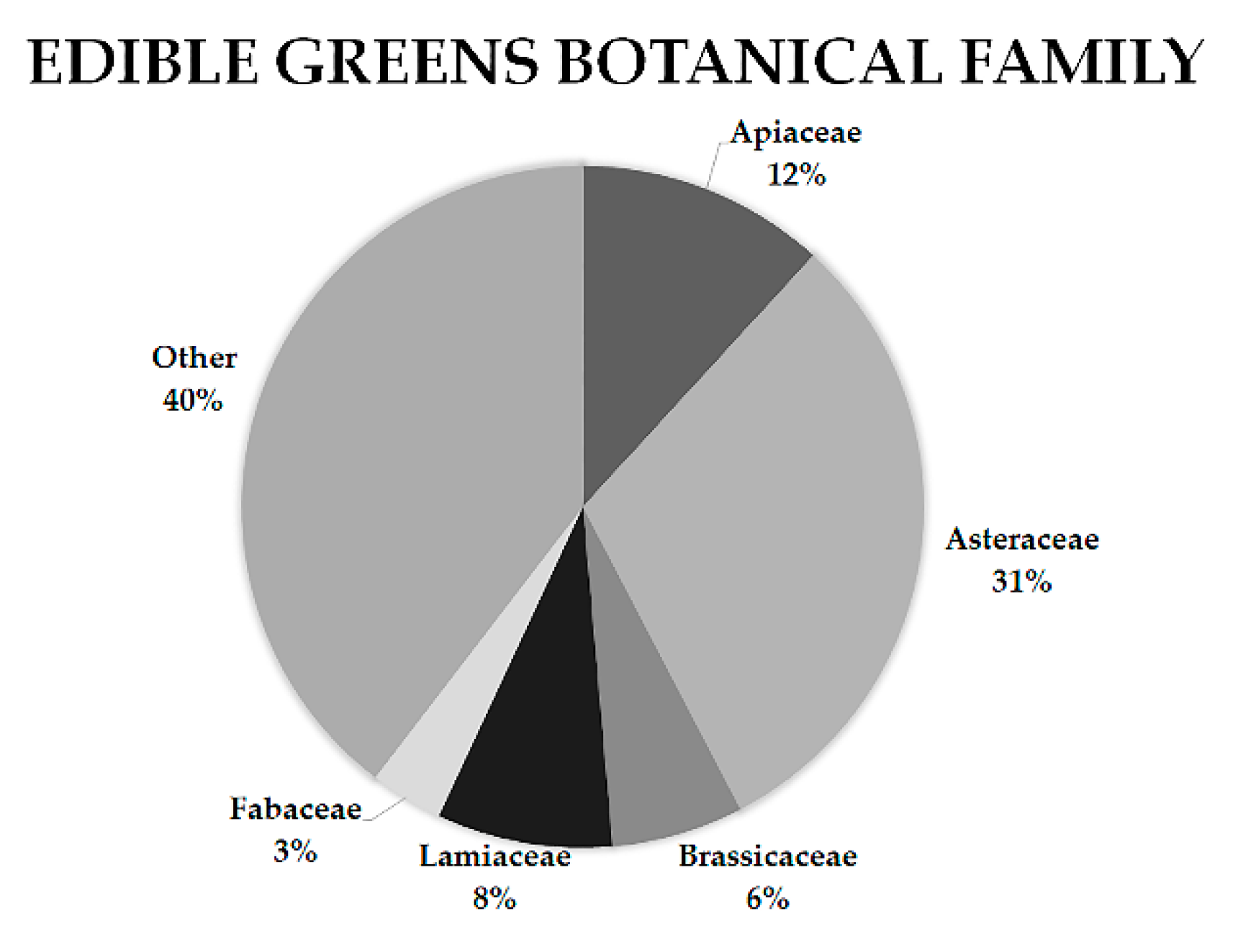
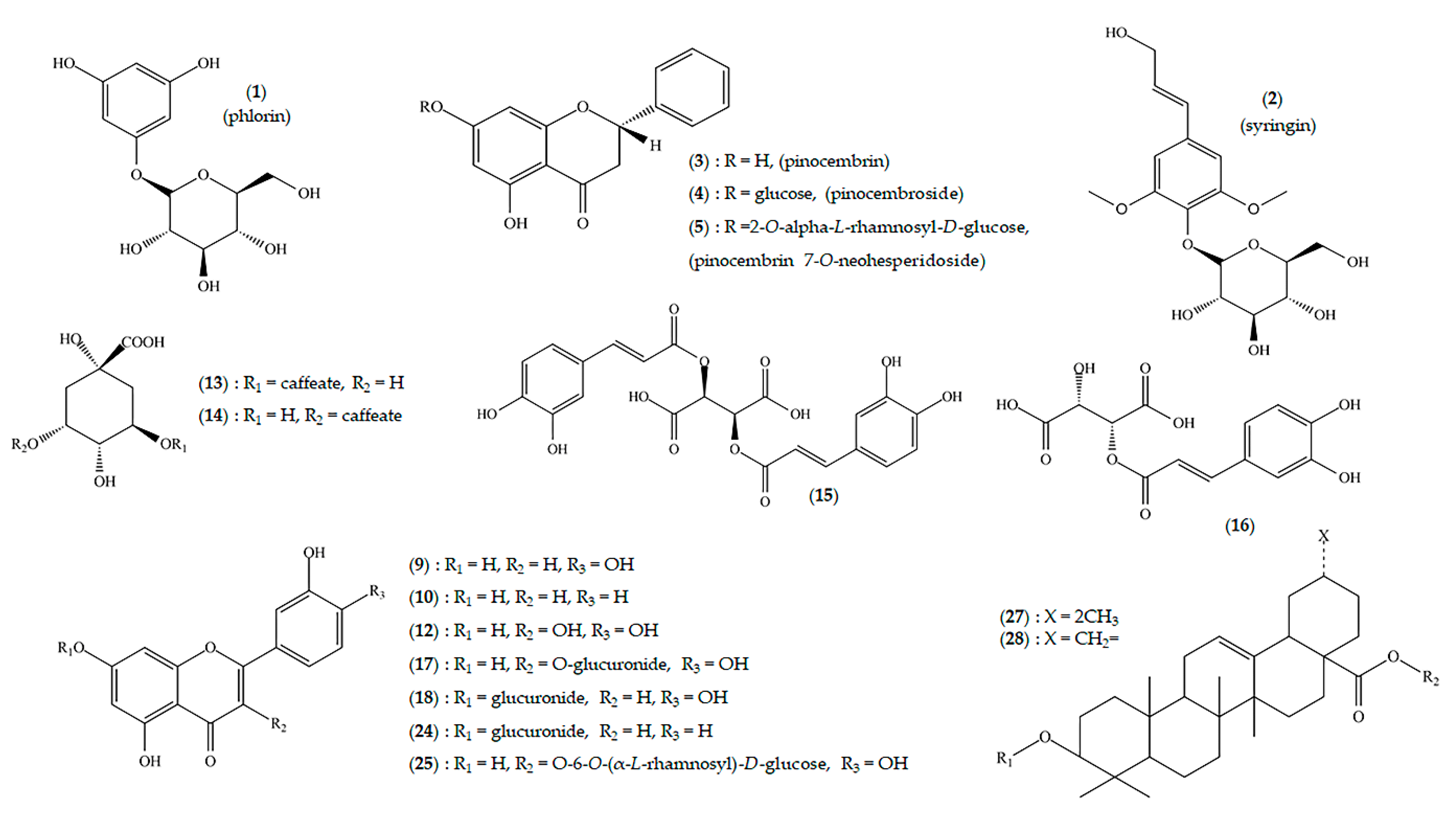
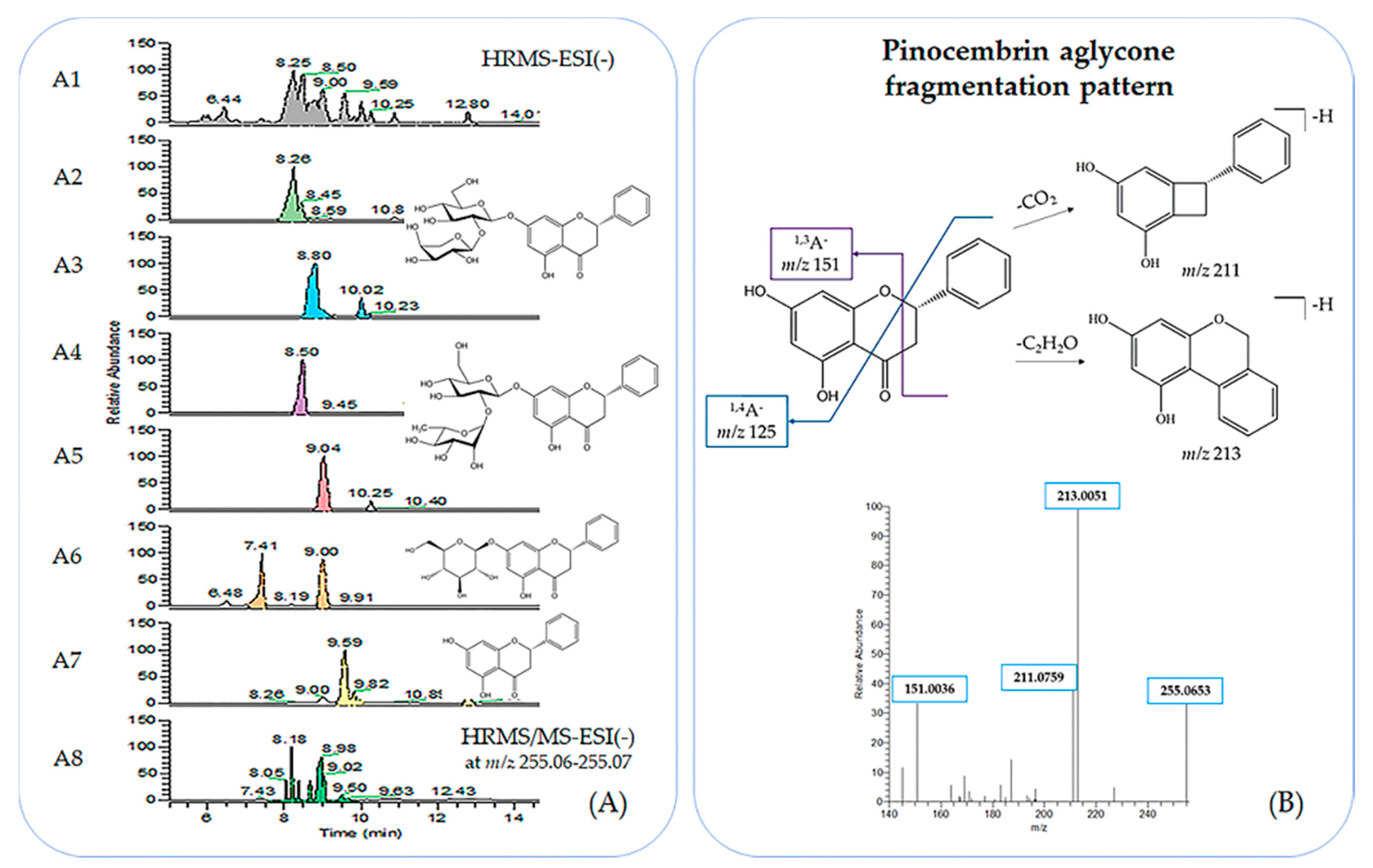
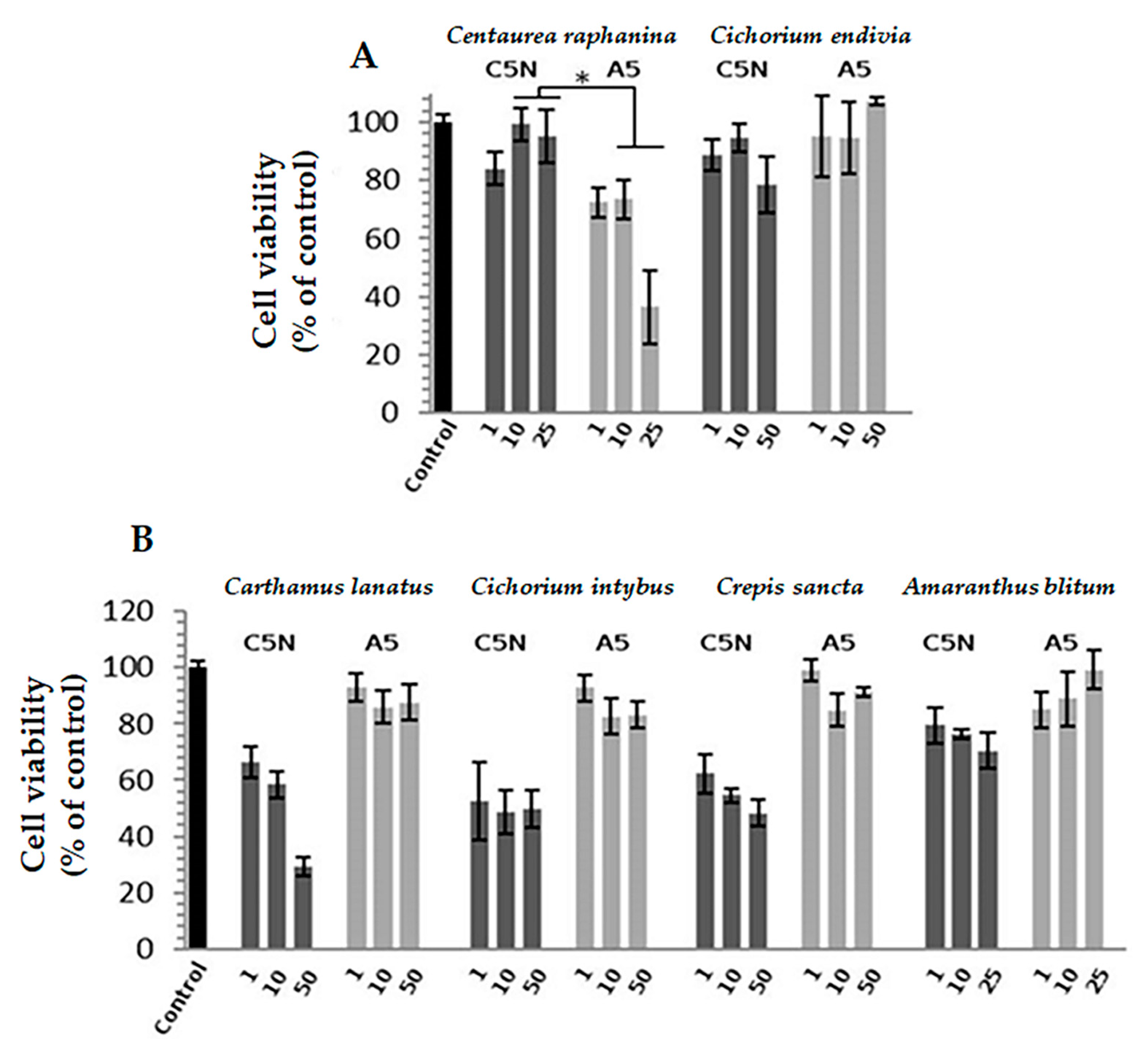
| Rt (min) | Detected m/z ([M − H]−) | HRMS/MS Fragment Ions (Relative Intensity) | Elemental Composition | RDBeq. | Δ (ppm) | Compound 1 | Chemical Class |
|---|---|---|---|---|---|---|---|
| 0.76 | 165.0408 | - | C5H9O6 | 1.5 | 2.355 | heptonic acid | organic acids |
| 0.79 | 191.0564 | - | C7H11O6 | 2.5 | 1.249 | quinic acid | organic acids |
| 0.90 | 133.0147 | 115 (100) | C4H5O5 | 2.5 | 3.559 | malic acid | organic acids |
| 0.96 | 191.0199 | 111 (100), 173 (16) | C6H7O7 | 3.5 | 1.121 | citric acid | organic acids |
| 0.99 | 287.0773 | - | C12H15O8 | 5.5 | 4.201 | phlorin | phloroglucinol |
| 1.01 | 147.0304 | 129 (100), 85 (90) | C5H7O5 | 2.5 | 3.288 | hydroxyglutaric acid | organic acids |
| 3.81 | 353.0872 | 191 (100), 179 (7) | C16H17O9 | 8.5 | −1.743 | 5-caffeoylquinic acid | hydroxycinnamates |
| 3.83 | 417.1394 | - | C18H25O11 | 6.5 | −2.001 | syringin formate | phenylpropanoids |
| 4.40 | 179.0349 | 135 (100), | C9H7O4 | 6.5 | −0.235 | caffeic acid | hydroxycinnamates |
| 4.64 | 337.0921 | 191 (100), 173 (12), 163 (8) | C16H17O8 | 8.5 | −2.257 | 5-p-coumaroylquinic acid | hydroxycinnamates |
| 4.74 | 431.1913 | - | C20H31O10 | 5.5 | −2.134 | unknown | - |
| 5.10 | 479.0822 | 317 (100) | C21H19O13 | 12.5 | −1.886 | myricetin glucoside | flavonol glycosides |
| 5.83 | 463.0876 | 301 (100) | C21H19O12 | 12.5 | −1.402 | quercetin glucoside | flavone glycosides |
| 5.88 | 447.0928 | 285 (100) | C21H19O11 | 12.5 | −1.017 | luteolin glucoside | flavone glycosides |
| 5.91 | 461.0721 | 285 (100) | C21H17O12 | 13.5 | −1.017 | luteolin glucuronide | flavone glycosides |
| 6.01 | 579.1346 | 285 (100) | C26H27O15 | 13.5 | −1.560 | luteolin pentoside hexoside | flavone glycosides |
| 6.25 | 515.1188 | 353 (100), 299 (7) | C25H23O12 | 14.5 | −1.416 | 4,5 dicaffeoylquinic acid | hydroxycinnamates |
| 6.27 | 581.1866 | 461 (100), 491 (26), 299 (13) | C27H33O14 | 11.5 | −1.719 | kaempferid pentoside hexoside | flavonol glycosides |
| 6.44 | 355.1396 | 173 (100), 161 (22), 143 (21) | C17H23O8 | 6.5 | −0.538 | 9-O-methylconiferin | phenylpropanoids |
| 7.42 | 417.1183 | 211 (100), 237 (25), 255 (13) | C21H21O9 | 11.5 | −1.955 | liquiritine | flavanone glycosides |
| 7.57 | 193.0506 | - | C10H9O4 | 6.5 | −0.011 | ferulic acid | hydroxycinnamates |
| 8.25 | 549.1609 | 255 (100), 429 (26), 297 (21), 279 (8) | C26H29O13 | 12.5 | −0.863 | pinocembrin arabinosyl glucoside | flavanone glycosides |
| 8.50 | 563.1763 | 255 (100), 297 (27), 443 (26), 401 (8) | C27H31O13 | 12.5 | −1.321 | pinocembrin neohesperidoside | flavanone glycosides |
| 8.63 | 591.1711 | 255 (100), 549 (57), 429 (42), 279 (18), 297 (15) | C28H31O14 | 13.5 | −1.436 | pinocembrin acetyl arabinosyl glucoside | flavanone glycosides |
| 9.04 | 417.1189 | 255 (100) | C21H21O9 | 11.5 | −0.564 | pinocembroside | flavanone glycosides |
| 9.06 | 605.1867 | 255 (100), 563 (97), 545 (49), 443 (40), 401 (12) | C29H33O14 | 13.5 | −1.436 | pinocembrin acetyl neohesperidoside | flavanone glycosides |
| 9.59 | 255.0664 | 213 (100), 211 (42), 151 (34), 187 (17), 145 (12), 169 (10) | C15H11O4 | 10.5 | 0.423 | pinocembrin | flavanones |
| 9.82 | 459.1291 | - | C23H23O10 | 12.5 | −1.263 | pinocembrin acetyl glucoside | flavanone glycosides |
| 10.01 | 591.1711 | 255 (100), 429 (50), 549 (20), 279 (17), 297 (16) | C28H31O14 | 13.5 | −1.436 | pinocembrin acetyl arabinosyl glucoside | flavanone glycosides |
| 10.27 | 605.1858 | - | C29H33O14 | 13.5 | −2.956 | pinocembrin acetyl neohesperidoside | flavanone glycosides |
| 10.89 | 459.1292 | 255 (100) | C23H23O10 | 12.5 | −1.067 | pinocembrin acetyl glucoside | flavanone glycosides |
| 12.80 | 255.0661 | 213 (100), 211 (42), 151 (36), 187 (16), 145 (9), 169 (7) | C15H11O4 | 10.5 | −0.714 | pinocembrin isomer | flavanones |
| Botanical Name | Centaurea raphanina | Carthamus lanatus | Cichorium intybus | Cichorium endivia | Cichorium spinosum | Crepis sancta | Sonchus asper | Amaranthus blitum |
|---|---|---|---|---|---|---|---|---|
| Common Greek Name | Agkinaráki | Gourounáki | Radíki | Agourorádiko | Stamnagkáthi | Ladáki | Zochós | Vlíto |
| Small dicarboxylic acids | + | + | + | + | + | + | + | + |
| Caffeoyl-quinic acids | + | + | + | + | + | + | + | − |
| Caffeoyl-tartaric acids | − | − | + | + | + | + | + | − |
| Flavonols and Flavones | + | + | + | + | + | + | + | + |
| Flavanones (pinocembrin derivatives) | + | − | − | − | − | − | − | − |
| Sesquiterpene lactones | − | − | + | + | + | + | − | − |
| DPPH * (IC50 μg/mL) | 120.60 ± 15.10 | 8.86 ± 0.82 | 10.64 ± 0.92 | 7.51 ± 1.20 | 15.08 ± 62.05 | 13.43 ± 2.02 | 13.56 ± 3.19 | 85.38 ± 7.51 |
© 2018 by the authors. Licensee MDPI, Basel, Switzerland. This article is an open access article distributed under the terms and conditions of the Creative Commons Attribution (CC BY) license (http://creativecommons.org/licenses/by/4.0/).
Share and Cite
Mikropoulou, E.V.; Vougogiannopoulou, K.; Kalpoutzakis, E.; Sklirou, A.D.; Skaperda, Z.; Houriet, J.; Wolfender, J.-L.; Trougakos, I.P.; Kouretas, D.; Halabalaki, M.; et al. Phytochemical Composition of the Decoctions of Greek Edible Greens (Chórta) and Evaluation of Antioxidant and Cytotoxic Properties. Molecules 2018, 23, 1541. https://doi.org/10.3390/molecules23071541
Mikropoulou EV, Vougogiannopoulou K, Kalpoutzakis E, Sklirou AD, Skaperda Z, Houriet J, Wolfender J-L, Trougakos IP, Kouretas D, Halabalaki M, et al. Phytochemical Composition of the Decoctions of Greek Edible Greens (Chórta) and Evaluation of Antioxidant and Cytotoxic Properties. Molecules. 2018; 23(7):1541. https://doi.org/10.3390/molecules23071541
Chicago/Turabian StyleMikropoulou, Eleni V., Konstantina Vougogiannopoulou, Eleftherios Kalpoutzakis, Aimilia D. Sklirou, Zoi Skaperda, Joëlle Houriet, Jean-Luc Wolfender, Ioannis P. Trougakos, Dimitrios Kouretas, Maria Halabalaki, and et al. 2018. "Phytochemical Composition of the Decoctions of Greek Edible Greens (Chórta) and Evaluation of Antioxidant and Cytotoxic Properties" Molecules 23, no. 7: 1541. https://doi.org/10.3390/molecules23071541
APA StyleMikropoulou, E. V., Vougogiannopoulou, K., Kalpoutzakis, E., Sklirou, A. D., Skaperda, Z., Houriet, J., Wolfender, J.-L., Trougakos, I. P., Kouretas, D., Halabalaki, M., & Mitakou, S. (2018). Phytochemical Composition of the Decoctions of Greek Edible Greens (Chórta) and Evaluation of Antioxidant and Cytotoxic Properties. Molecules, 23(7), 1541. https://doi.org/10.3390/molecules23071541








